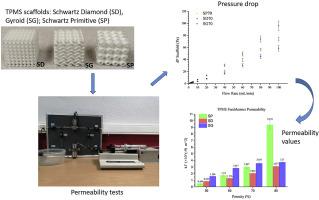Journal of the Mechanical Behavior of Biomedical Materials ( IF 3.3 ) Pub Date : 2020-07-03 , DOI: 10.1016/j.jmbbm.2020.103932 Jorge Santos 1 , Tiago Pires 1 , Bárbara P Gouveia 1 , André P G Castro 1 , Paulo R Fernandes 1

|
This study presents an experimental evaluation of permeability of triply periodic minimal surfaces (TPMS). Permeability is widely used to characterize scaffolds for Tissue Engineering (TE) applications as it gives information about the structure porosity, pore size, tortuosity and pore interconnectivity which have an important impact in cell seeding and proliferation. Three different TPMS structures were used: Schwartz Diamond (SD), Gyroid (SG) and Schwartz Primitive (SP), in four different porosity levels (50, 60, 70 and 80%). Overall, the SG scaffold type was determined to be the most permeable one while the SD was the least permeable. Furthermore, the presence of microscopic inertial pressure losses was verified and the Forchheimer's law proved to be a good mathematical tool as a Darcy's law expansion for the calculation of the structure's permeability while the weak-inertia regime was hard to detect or quantify.
中文翻译:

关于TPMS支架的渗透性。
这项研究提出了三次周期性最小表面(TPMS)的渗透性的实验评估。渗透性被广泛用来表征组织工程(TE)应用的支架,因为它提供了有关结构孔隙度,孔径,曲折度和孔互连性的信息,这些信息对细胞接种和增殖具有重要影响。使用三种不同的TPMS结构:四种不同的孔隙度水平(50%,60%,70%和80%)的Schwartz Diamond(SD),Gyroid(SG)和Schwartz Primitive(SP)。总体而言,SG脚手架类型被确定为最可渗透的,而SD则为最不渗透。此外,微观惯性压力损失的存在也得到了验证,并且作为达西定律,Forchheimer定律被证明是一个很好的数学工具。











































 京公网安备 11010802027423号
京公网安备 11010802027423号